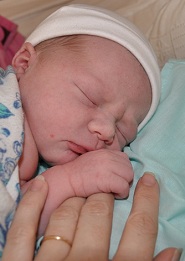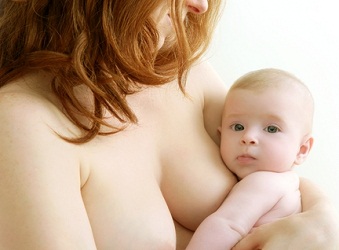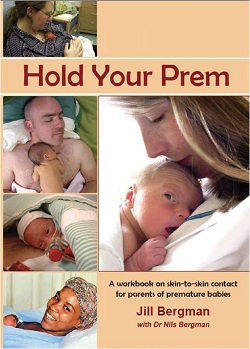Kangaroo Mother Care
Research has shown that all newborn babies and especially premature babies need kangaroo mother care (KMC). Read what this is and why it is so important for babies.
 The transition from the womb to the outside world, is a big adjustment for the newborn and how the baby experiences his first moments and hours after birth will set the pattern for how that baby will come to perceive the world.
The transition from the womb to the outside world, is a big adjustment for the newborn and how the baby experiences his first moments and hours after birth will set the pattern for how that baby will come to perceive the world.
A baby that finds that she is loved, cared for, fed and nurtured will have the best start in life, both physically and emotionally and this will facilitate optimal brain development.
By contrast, a baby that is separated from the mother will become highly stressed as she instinctively knows that her survival is dependent on her mother's presence. High stress levels have long term side effects on the baby's physical and emotional health.
Kangaroo mother care also benefits parents because it encourages attachment and bonding, increases parental confidence, and helps to increase milk production and facilitates breastfeeding success.
Therefore, a mother and baby should be considered a dyad - a pair that should not be separated, but kept together from birth.
Not only is separation unnatural and abnormal, but it is also harmful to the newborn and should be avoided!.
What is Kangaroo Mother Care?
KMC has been defined as a model of care for all newborns, but especially for premature babies, consisting of three components:
- Skin-to-skin contact
- Exclusive breastfeeding
- Support to the mother-infant dyad

KMC involves keeping a mother and her newborn baby together skin-to-skin, 24 hours a day, with the baby having unrestricted access to the breast at all times.
KMC has saved the lives of countless premature babies, who would have died without the miracle of their mothers' touch.
The practice was first studied in Bogota, Columbia in 1978.
As a result of a shortage of incubators in their hospitals, doctors started placing premature newborns on their mothers' chests, wearing only a knitted cap and a warm blanket for cover. The mortality rate dropped and the premature babies made good progress.
The babies of more affluent women, who were placed in incubators in the hospitals in the upmarket areas, were more sickly than the babies in the poorer communities, where kangaroo mother care was practiced.
Since then several hundred studies have been done around the world, showing the benefits of KMC for all healthy, stable newborn babies, whether premature or full-term.
"Like other mammals, human babies thrive in their 'correct habitat' - on the warm bodies of their mothers," says Dr. Nils Bergman, one of the pioneers of Kangaroo Mother Care in South Africa.
Skin-to-Skin Contact
Research has shown that being placed skin-to-skin on the mother's chest stabilizes a baby better than an incubator. A mother's body is able to increase or decrease the temperature of her chest, to help stabilize the baby's body temperature - more effectively than an incubator! This phonemenon is known as maternal-infant thermal synchrony.
The baby is soothed and comforted by the mother's heartbeat, her familiar smell and the sound of her voice. Her touch and regular breathing also calm and stabilize the baby.
KMC also helps to improve sleep patterns of infants, which is important for good growth and development.
Click here to read more about the importance of skin-to-skin contact.
Benefits of Breastfeeding for (Premature) Babies
Breastfeeding is an integral part of kangaroo mother care. If babies are too immature to suck, they should be tube-fed their mother's milk.
Colostrum, which is the first fluid produced by the mother is known as 'liquid gold' as it is so nutritious and beneficial for newborns. Even mothers that choose not to breastfeed should express the colostrum they produce and let their newborns enjoy the its benefits. It is highly nutritious, easily digestible, contains anti-bodies and prepares the baby's stomach for the mother's milk that will be produced the third day after birth.
The milk of a mother whose baby was born prematurely is quite different from that of the mother of a full-term baby. It contains special nutrients to help the premature baby to grow as well as essential anti-bodies which help to protect the infant from disease.
"Breastfeeding is a behaviour based on hindbrain functions that regulate hormones, autonomic functions and the somatic system."2
In layman's terms, it has been said that breastfeeding is 90% brainwiring and 10% nutritional!3
Supporting the Mother-Baby Dyad
Until recently, it was common practice, in Neonatal Intensive Care, to separate mothers and fathers from their babies. Newborns, believed to be too fragile and unstable to touch were kept in incubators.
However, new research shows that separating babies from their mothers is detrimental - making babies stressed and their vital signs unstable.
When held in skin-to-skin contact, babies feel safe and their vital signs stabilize.
If separation has occurred after birth, babies seem to recover almost immediately when they are re-united with their mothers. Their heart rate, breathing and temperatures return to normal and their stress hormones return to acceptable levels.
Previously, it was considered normal for babies in incubators to have fluctuating heart rates, breathing patterns and temperature. Doctors now know that these are signs of babies in distress!
As soon as a baby is back in the ideal 'habitat' on the mother's chest, these vital signs return to normal very quickly.
When premature babies need life-support such as IV's, tube feeding or oxygen, these procedures can also be combined with kangaroo mother care. The rule of thumb is add on technology!
In this way, a baby can receive the best of nature's KMC and the best of technology!
Ideally, babies should not lie alone in incubators if they can rather be on the mothers' or fathers' chests!
Click here to read more about Babywearing.
Choosing the Best Birth Venue
Because KMC is so vitally important for all newborn babies, you should investigate early in your pregnancy, the venue where you will give birth.
This would be of vital importance to you and your baby, should you go into labor prematurely! You surely wouldn't want you baby taken away from you and placed in an incubator in an NICU that does not practice kangaroo mother care!
Hospitals that encourage round the clock, skin-to-skin contact and exclusive breastfeeding are known as 'baby-friendly' hospitals. They have to meet rigorous standards to qualify for this rating from the World Health Organisation.
If there aren't any baby-friendly hospitals in your area, talk to the staff about your birth plan and your desire to practice kangaroo mother care or alternatively, consider planning a home birth. Research has shown that for low-risk, healthy mothers and babies, home births are no more risky than hospital births - in fact there are many other benefits too!
You also need to find a caregiver who understands the importance of kangaroo mother care. As more and more mothers ask for KMC, so healthcare providers will have to investigate it and implement KMC. You can help make it possible for other mothers and their babies too!
Back to Newborn Baby Care
References
- Moore ER, Anderson GC, Bergman N. Early skin-to-skin contact for mothers and their healthy newborn infants. Cochrane Database of Systematic Reviews 2007, Issue 3. Art. No.: CD003519. DOI: 10.1002/14651858.CD003519.pub2
- Dr. Nils Bergman, http://www.kangaroomothercare.com/whatis01.htm, retrieved 22 September 2010
- Personal notes from seminars presented by Dr. Nils Bergman, Cape Town, 21 August 2010 and 2 October 2010.
- Tessier, R., Cristo, M., Velez, S., Giron, M., Figueroa de Calume, Z., Ruiz-Palaez, J., Charpak, Y., & Charpak, N. (1998). Kangaroo mother care and the bonding hypothesis. Pediatrics, 102 (2), e17-33.
- Ludington-Hoe, S., Lewis, T., Morgan, K., Cong, X., Anderson, L., & Reese, S. (2006). Breast and infant temperatures with twins during shared kangaroo care. Journal of Ostetrics, Gynecologic, and Neonatal Nursing, 35 (2), 223-231.
- Conde-Agudelo, A., Diaz-Rossello, J., & Belizan, J. (2003). Kangaroo mother care to reduce morbidity and mortality in low birthweight infants. Cochrane Database Syst Rev, (2), CD002771.
- Kirsten, G., Bergman, N., & Hann, F. (2001). Part 2: The management of breastfeeding. Kangaroo mother care in the nursery. Pediatric Clinics of North America, 48 (2).
Hold Your Prem
KMC Book
In this book for parents of premature babies, Jill Bergman, wife of leading KMC pioneer, Dr Nils Bergman, describes in layman's terms, the key concepts from recent neuroscience and newborn care.
Jill helps parents deal with their emotional turmoil, as well as giving advice and practical tips to empower them to become central to the team for their preterm baby’s care in NICU and afterwards.
All you need to know and do to protect your baby’s brain development and give better quality of life for her future, is “Hold Your Prem” !
To order your copy, go to Hold Your Prem.
Disclaimer: All information is provided for informational purposes only, although every effort is made to provide accurate and current information.
The site content is not intended to be or to substitute for medical advice, diagnosis, or treatment.
Always seek the advice of a suitably qualified health care professional regarding your individual medical needs.
Pregnancy and Giving Birth.com is not responsible nor liable for any advice, course of treatment, diagnosis, services or products obtained via this website.
Return to Top of Kangaroo Mother Care
All Rights Reserved.


